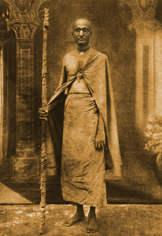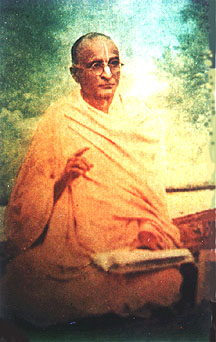Receive Your Personalised
Vaishnava Almanac
This page was compiled by
Jaya Tirtha Charan dasan
Introduction to the concept of Panjika:Sri Navadwip Panjika of Srila Bhaktisiddhanta Saraswati Thakur:
For those wishing more specific details about any given
day or time; or requiring research done for the best time to perform any
kind of auspicious works; astrological consultation, or bookings for the
performance of functions, yajnas or Pujas, etc., Pt. Jaya Tirtha Charan
dasa may be contacted at:
...

Our Vaishnava Calendar - Panjika is available HERE


(Harada – Sharad (autumn – August-Sept-Oct), Shishira (winter monsoon
-shivering/chilling – Oct-Nov-Dec), Hemanta (winter – Jan-Feb), Vasanta
(flower bearing spring – Feb-March), Grishma (warming summer – April-May),
and Varsha (the refreshment and replenishment of rainy season – summer
Monsoon – June-July/August).
...
This Panjika is also designed for use with Upavas, Parva,
and Utsava, or fasting, festivals, rites and feasts according to Vaisnava
Smriti Sri Hari Bhakti Vilas. The directions sanctioned in this Panjika
give the reasons for and method as to why devotees fast on certain days
such as Ekadasi, Mahadwadasi, and the appearance and disappearance days
of great Vaisnavas, and Gurus. If it is any great Vaisnavas appearance
day is followed by Mahadwadasi, it is the duty of the devotee to fast on
the following day, the Dwadasi and not on the Ekadasi. However if the appearance
day falls on an Ekadasi where there is no Mahadwadasi following, then the
fasting should be done on the Ekadasi and parana on the day of Dwadasi.
When there is no Mahadwadasi in the appearance of Vaisnava auspicious occasions,
it has been mentioned in Hari Bhakti Vilas that fasting is carried out
on the Ekadasi whereasthe actual worship, Pujas, and offerings of bhoga
to Deities of Visnu are to be offered on the Dwadasi. This subject is clearly
understandable when reference is made as an example to Sri Vaman Dwadasi,
(as mentioned in the Panjika). Throughout this book the directives of Sri
Hari Bhakti Vilas have been followed. On grasping the teachings of Gaudiya
Vaisnavas Acaryas mentioned herein we fast on the holy days of the appearance
day of Sri Caitanya Mahaprabhu, Sri Baladeva prabhu, and Sri Nityananda
prabhu hinged on the tithi based observance. Accordingly the requirements
are described for the observances in this Panjika. Fortunately,now some
other panjikas have statred to following our proceedures.
Form this it is clear that except Ekadasi, in other tithis if that is, if the previous tithi enters during sunrise, then this one is called bidhwa or penetrated. As regards to Ekadasi, if Dasami enters during sunray bidhwa, during 2 Muhurthas or 4 dandas = 1hour and 36 mins' of sunrise, then it would be considered Arunodaya bidhwa (prebidhwa).
Prebidhwa Nanda (Ekadasi through Sravan nakshatra, has
to be rejected. In the same way Janmastami, if Rohini is already connected.
We are requested to abandon due to prebidhwa. (HBV. 6.15.361)
.
In the footnote of the above mentioned verse, Srila Sanatana
Goswami has advised very clearly that IT IS NOT CORRECT to abandon Janmasthami
if the penetration by the Saptami comes during the Arunodaya the same way
as Ekadasi is done away with if penetrated by Dasami during Arunodaya.
The reason for this is that all other tithis other than Ekadasi are complete
if started at the sunrise, and thus their penetration during sunrise is
to be ignored.
It has to be remembered with great care that a tithi without
penetration is complete and pure in its self. Its ?
to look at a complete tithi as a penetrated one. The Gaudiya Vaisnava Acarya
Srila Baladeva Vidyabhusana prabhu has written about this very clearly
in Prameyar Ratnavali 816 Prameya 9th verse.
.
Only Ekadasi observation is to be given up in care of
Arunodaya; all others including Janmasthami are to be avoided if only penetrated
by sunrise penetration. Sri Srimad Prabhupada108 Srila Bhaktisiddhanta
Sarasvati Goswami Thakur, who is the founder of Sri Caitanya and other
Mathas has described in Sri Caitanya Caritamrta Madhya lila 24.337 stanza.
"Abandon Ekadasi with Arunodaya bidhwa and other rites with Surjyodaya
bidhwa and observe all other Abidhwa vratas (unpenetrated rites). The former
causes sin and the later brings devotion to the Supreme Lord."
.
There are eight Mahadwadasis, among them (Unmavisnu),
Unmilani, Vyanjuli, Trisprisha and Paksavardini these are all called Tithi
ghatita, or that there cause is tithi based. Jaya, Vijaya, Jayanti, and
Papanashini these four are caused due to the nakshatra being still active
after the Ekadasi touches the next day (morning).
.
If any Ekadasi tithi exceed the following morning or
Pratakal then the next day is called Unmilani Mahadwadasi. If Ekadasi tithi
is not complete and Dwadasi is extended to the Tryodasi then this is called
Vyanjuli Mahadwadasi. If any Ekadasi tithi stretches through Dwadasi night
to Tryodasi then this is called Trisprisha Mahadwadasi (Triple touched).
If Ekadasi undergoes some extension and falls on the Amavasya or Purnima
then it is called Paksavardhini Mahdwadasi.
.
Then we have the nakshatra based observances. If sukla
(Gaura) Dwadasi is having as its nakshatra Punarvasu then this is called
Jaya Ekadasi. If it is attached to Sravan nakshatra then it is called Vijaya,
attached to Rohini nakshatra it is called Jayanti Ekadasi and attached
to Pusya (Pausa) nakshatra then it is called Papanasini Ekadasi.
.
If the Tithi or Nakshatra's maan or quality is the whole
night then it is full 60 danda. From the beginning of sunrise on Ekadasi
to the next sunrise is 64 dandas. If Dwadasi remains up to sunset on the
Punarvasu, Rohini and Pusya nakshatras it is automatically then to be called
Mahadwadasi. If Dwadasi continues upto midday with Sravan naskshatra this
is to be called Vijay Mahadwadasi.
NOTE:
From the perspective of the followers of Sripad Madhwacharya there's
a small but well composed message from one devotee responding to a suggestion
that it would be okay to follow one calendar - almanac for ekadasi just
as western calendars do in having a set day relating to the movements of
the Sun through the time zones of the world and the international date
line. Here he explains nicely some basic differences in the concept of
calendars and our Vaishnava almanacs (panchangam). In his final note he
makes the point, that we don't have to try to analaize everything to pieces,
but rather just follow the panchanga accoring to the teachings of the parampara
acharyas. Factually, the layman doesn't need to know every aspect of such
things, just like one going for a surgical operation we don't need to know
each and every aspect of the operation, rather we need to have faith that
the Acharyas are competent, that the parampara is fixed in desemination
through proven quotes from the purva-acharyas and shastra. In that way,
in confidence we will have the required faith. See that message HERE.
See our Ekadasi pages HERE
Our Astrological pages - for all your astrological works:
Our Atronomical links - to help you re-affirm our Vaishnava conclusions:
Our Vaishnava Calendar - Panjika is available HERE (2000-2001& 2001-2002 & 2002 - 2003 & 2003 - 2004)
(.................if the download facility doesn't work contact me and I can send you a calendar for FREE for your location - just send me an e-mail, and I'll get back to you to affirm you're genuine, and not like some I get that's address doesn't exist when I get back to them =>:-))
Here's an Excellent Time Placement and Astrological Tool that shows all aspects of the Panchangam, and casts Astrological charts, a necessity for the Pandit and the layman alike:
For all their equipment, and all their money first and foremost we accept the Vaishnava conclusion above that of the scientists. Our founder-acharya Srila A.C. Bhaktivedanta Swami Prabhupad was time and time again adamant that what we see with our blunt senses is not always correct, rather we understand that there is a process to understand what is the truth, and that is through the Pramanam system (see our pages on that). Like it or not we have to accept authority, and the Vedik / Vaishnava authority on these subjects are clear. If we undermine the Vedik conclusions and accept the scientists as authorities we are going against the teachings of our previous acharyas, simple as that. =>:-))
Download a FREE Eggless Cake Cookbook HERE:
![]()
![]()